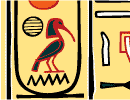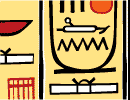|
Click Here to Create a Custom Cartouche of Your Name or Phrase with the Fun and Popular Hieroglyph Translator
|
|

|

All trademarks and copyrights on this page are owned by their respective owners.
The Rest Copyright 1998-2012 All Rights Reserved www.Virtual-Egypt.com
|
|

|
|
Macromedia Flash
Hieroglyphic
Translator

Macromedia Flash
Hieroglyphic
Screen Saver

|
|
|





